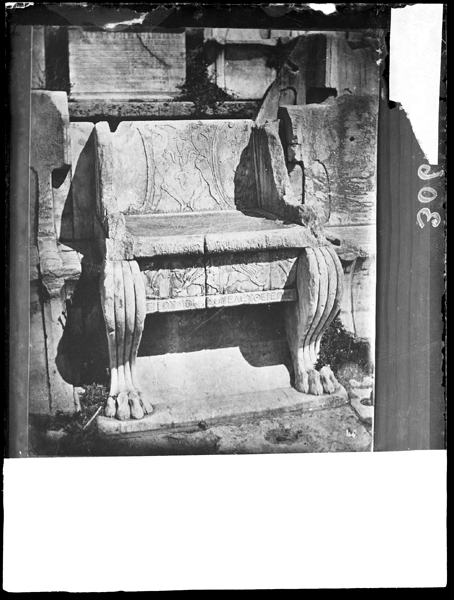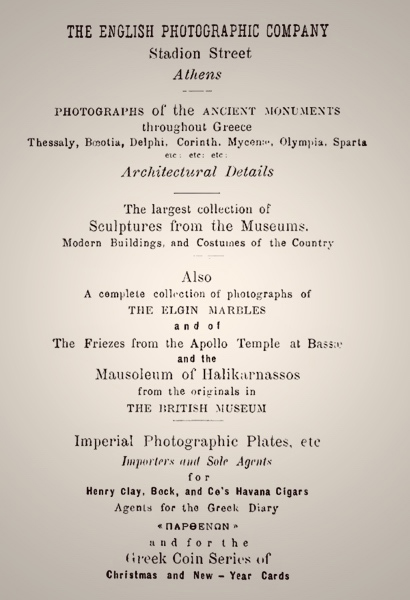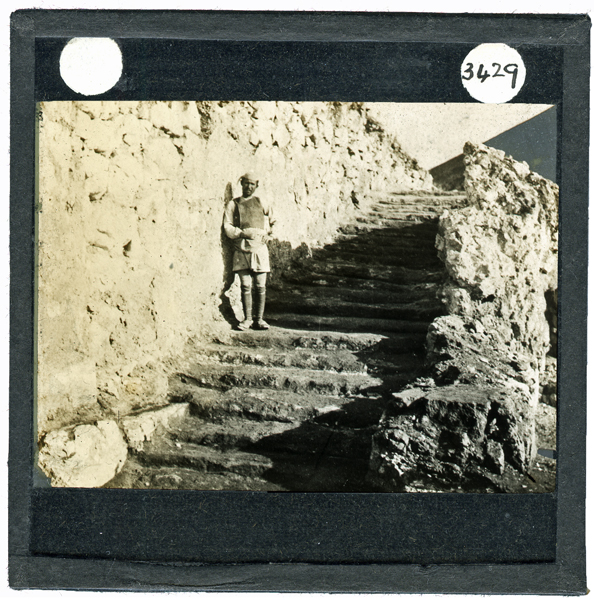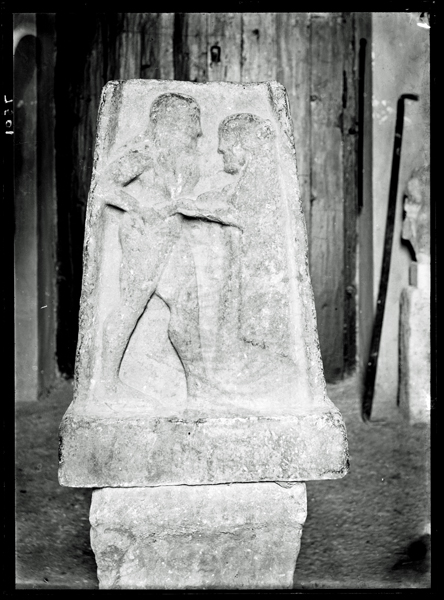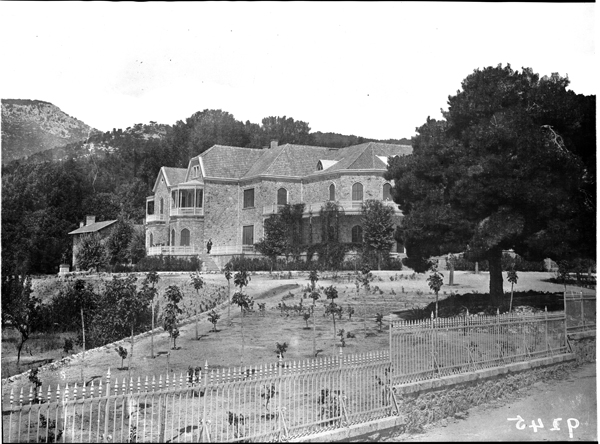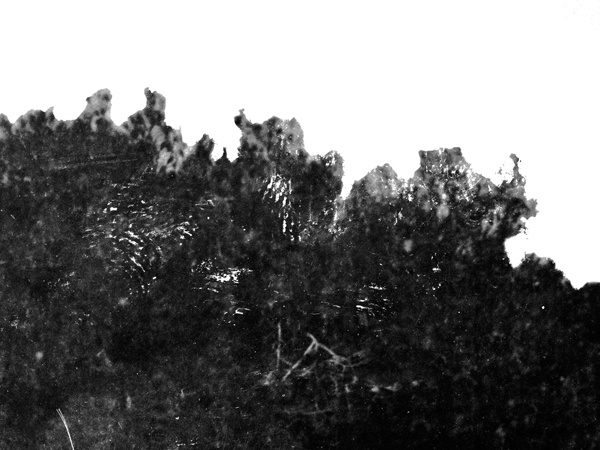The English Photographic Company and the BSA SPHS Image Collection
The name English Photographic Company crops up here and there in the BSA SPHS Image Collection records. Some negatives in the collection contain written notations, “Eng. Photo Co.” on the photographs and others record the source in the negative registers. All of them are copy negatives, that is, secondary negatives copied from the other negatives (often the master or original) or from positive prints.
The first negatives that can be identified as English Photographic Company images were donated by the Cambridge scholar Jane Harrison and by William Barclay Squire of the British Museum music department. Both Harrison’s and Barclay Squire’s donations were listed in the 1897 slide catalogue and must pre-date this time.
English Photographic Company images appear in numerous publications in the 1890s and the early 20th century. The 1896 part I and 1897 part II of A Handbook of Greek Sculpture by E.A. Gardner and the 1911 book, The Glory that was Greece: A Survey of Hellenic Culture and Civilisation, by J.C. Stobart are prime examples. However, these publications did not provide information about the company.
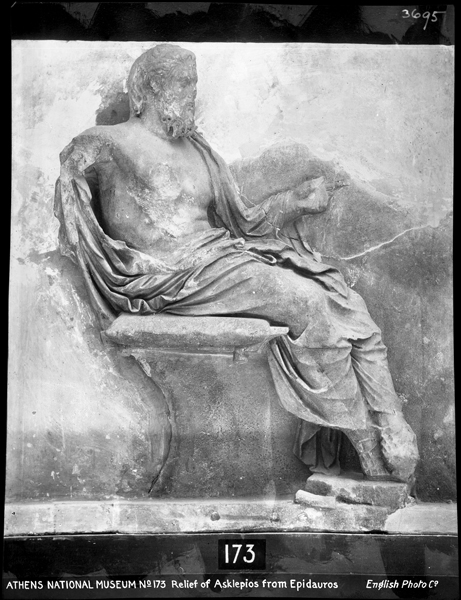
BSA SPHS 01/5053.3695, Sculpture of Asclepios from Epidaurus in the National Archaeological Museum, Athens (p. 389, fig. 95 in Gardner, E.A. 1897. A Handbook of Greek Sculpture. Pt. II. London: Macmillan)
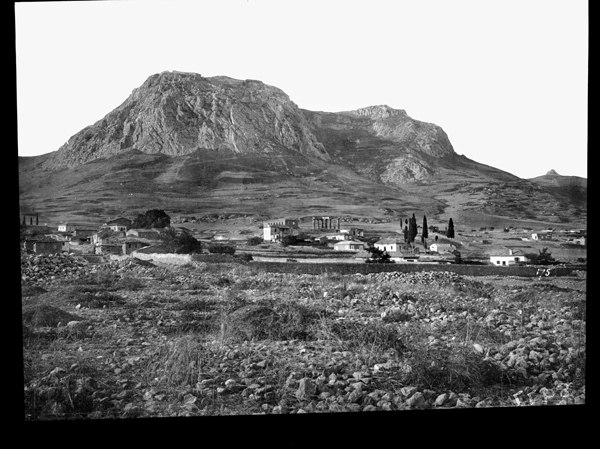
BSA SPHS 01/4359.8977, General view with old temple at Ancient Corinth with Acrocorinth behind (pl. I, fig. 2 in Stobart, J.C. 1911, The Glory that was Greece: A Survey of Hellenic Culture and Civilisation. London: Sidgwick & Jackson.
A good source of information about the company are travel guide books. When looking through various editions of the Murray’s Handbooks to Greece, tantalising bits of evidence began to appear. Up to and including the 5th edition (1884), there is no mention of the company although they list photographers and booksellers along with hotels, cafes, shops and various services available in Athens. Nor was there any mention in the 1889 (1st English edition) and the 1894 (2nd edition) of Baedeker’s Handbook of Greece.
The first mention of the company appears in the 1896 (6th) edition of Murray’s Handbook to Greece as one of a number of photographic companies and studios in Athens. It is listed in the Index and Directory under the heading of Athens – Photography. The shop was located on Stadium (Stadiou) Street. That same year, Mrs Vernon Delves-Broughton published her illustrated Hand Book to the Antiquities of Athens which contains a full-page advertisement for the company in back of book (see below). Murray’s 7th and final edition (1900) repeats most of the information from the 6th edition, but now places the shop of the English Photographic Company on Palace Square (Syntagma Square), close to the beginning of Stadium Street.
Five years later, in 1905, the company appears again in 3rd English edition of the Baedeker Handbook to Greece. However, at this point, it mentions that photographs from the English Photographic Company, associated with the name J.K. Atchley, were sold in the shop of Charles Beck, a well-known bookseller in Athens.
The name J.K. Atchley is probably a corruption of S.C. Atchley who appears as a donor in the SPHS negative registers linked with deposits of negatives from the English Photographic Company. In fact, there are two blocks of donations of English Photographic Company negatives via Atchley: one group probably prior to 1897 and another post-1904/pre-1913 based on presence or absence of images within those groups that were published in SPHS Slide Catalogues of 1897, 1904 and 1913.
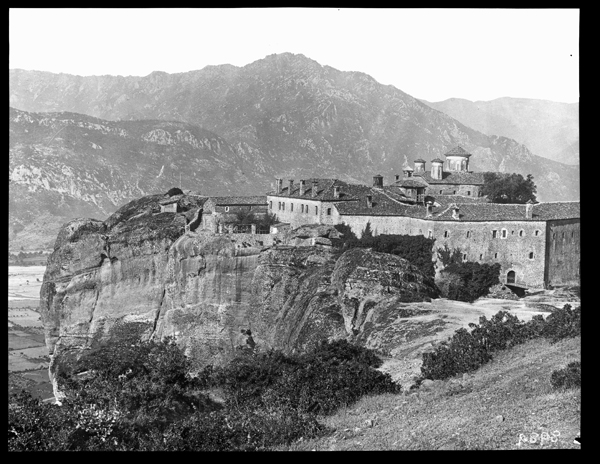
BSA SPHS 01/4370.8989, Meteora: Monastery of Ayios Stephanos (first appearing in the SPHS 1913 catalogue)
More confirmation of Shirley Clifford Atchley’s affiliation with the company comes from his obituary in The Times (22 June 1936). It clearly states that he was a partner in the English Photographic Company. By the time of his death he had been resident in Greece since leaving England in 1887 when he was 17 years old. This chronology means that the company had to post-date 1887 and accounts for its absence in the earlier Murray’s Handbooks.
By 1906, when Percy Gardner wrote his book, Classical Archaeology in Schools, the English Photographic Company is mentioned on p. 24 and 29 in the sources for photographs of antiquities. Of course, it mentions that a “full set” of images are available at the SPHS and via W. Barth on University Street, Athens. There is a direct connection between C. Beck who is mentioned in the 1905 Baedeker and W. Barth. From 1901 to 1909, C. Beck and W. Barth merged to form a publishing house and bookstore in Athens, first on University Street and later on Palace de la Constitution (Syntagma Square), as indicated in the 4th (1909) English edition of Baedeker’s guide. In addition, both Beck and Barth are mentioned in relation to acquisition of English Photographic Company photographs in the 1906 publication of the Catalogue of the Sparta Museum by BSA scholars, A.J.B. Wace and M. Tod. The catalogue publishes several of their photographs of Laconian antiquities. In turn, the BSA gave these English Photographic Company negatives to the SPHS photographic collection.
In 1921, Atchley donated nearly 1,000 of his own images (most original film negatives) to the SPHS. Among the extant negatives, I was able to demonstrate that a few of his photographs match English Photographic Company photos that he had donated earlier. That makes him both a partner and company photographer, a pivotal figure in the English Photographic Company.
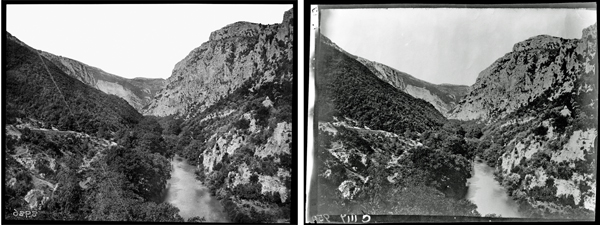
Left: BSA SPHS 01/4367.8986, View of the Vale of Tempe by the English Photographic Company; Right: BSA SPHS 01/5328.C1117, Same view by S.C. Atchley (donated in 1921)
Because these were commercial images, they were copied, printed, made into lantern slides and possibly into postcards. The subject matter of the photographs – based on the advertisement in Mrs Vernon Delves-Broughton’s 1896 guidebook, images in publications and extant images in the SPHS – is wide-ranging from antiquities, the Greek countryside as far north as Thessaly and modern buildings or monuments of significance.
The negatives in the SPHS collection also provide evidence that this was a working collection consisting primarily of copy negatives as demonstrated by the evidence of retouching. This can be seen in comparing the two photographs of the Vale of Tempe above: the English Photographic Company image as been retouched, producing a uniform white sky compared to the variations in grey seen in the original negative by Atchley. Another example of retouching can be seen in the treetops of the photograph of Tatoi (BSA SPHS 01/4491.9245 below). Painting over the sky to remove imperfections such as fingerprints and dust particles that occur on a negative when being copied was a common technique. This example shows where the retouching roughly followed the line at the top of the tree, not fine enough to cover all the sky shown through the leaves and branches as you can see in the enlarged section below where remains of a fingerprint can also be seen.
My best guess is the company was a short-lived one, competing with other photographic suppliers, beginning sometime between 1894 and 1896 when it is first mentioned and lasting no longer than ten years. Despite its name, it was never a company in England, but established in Athens. Beck and Barth took over marketing the photographs at least by 1905. I was unable to consult a rare publication by W. Barth entitled Hellas: From photographs by the English Photographic Co.. However, I suspect it is a catalogue of available English Photographic Company photographs through Barth’s publishing house. According to worldcat.org, there are extant copies of this publication dating to 1910 (in the Erlangen-Nuremberg University Library) and 1920 (in the University of Zurich), so it appears that Barth was probably still marketing the photographs up until this time.
By the late 1920s, however, English Photographic Company images were advertised by B. Papagiannopoulos, whose shop was located on the Place de la Constitution. Papagiannopoulos is mentioned as a supplier of English Photo Company photographs and excellent picture postcards in Ante Oculos, a pamphlet compiled by J. Penoyre in 1929. Ante Oculos was a comprehensive source for pictures in Classical teaching in schools, published by the SPHS twenty-three years after Percy Gardner’s similar (although not as comprehensive) source list in Classical Archaeology in Schools.
The English Photographic Company had produced quality photographs from the late 19th century of Athens and places further afield. The company’s influence lived on after its first flush of activity. Their photographs appeared in publications at the end of the 19th century and into the early 20th. They were continued to be marketed by various bookshops and photographic suppliers in Athens and mentioned in teaching resources. Shirley Atchley also donated English Photographic Company images to the SPHS, many of which were reproduced as slides for their lending library, ensuring an even greater audience for the images. Many of the English Photographic Company images are now in the BSA SPHS photographic collection.
Deborah Harlan
British School at Athens
Images from the BSA-SPHS collection are available on the BSA’s Digital Collections page.
Click here for more BSA Archive Stories.
